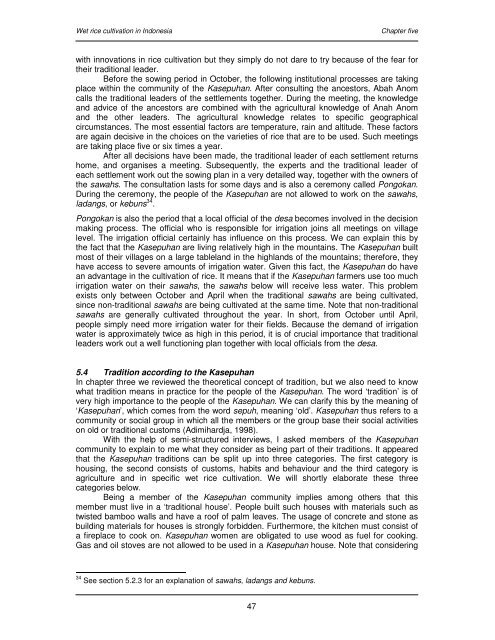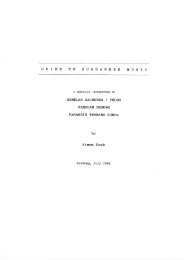Wet rice cultivation in Indonesia - Free EBooks Library
Wet rice cultivation in Indonesia - Free EBooks Library
Wet rice cultivation in Indonesia - Free EBooks Library
You also want an ePaper? Increase the reach of your titles
YUMPU automatically turns print PDFs into web optimized ePapers that Google loves.
<strong>Wet</strong> <strong>rice</strong> <strong>cultivation</strong> <strong>in</strong> <strong>Indonesia</strong> Chapter five<br />
with <strong>in</strong>novations <strong>in</strong> <strong>rice</strong> <strong>cultivation</strong> but they simply do not dare to try because of the fear for<br />
their traditional leader.<br />
Before the sow<strong>in</strong>g period <strong>in</strong> October, the follow<strong>in</strong>g <strong>in</strong>stitutional processes are tak<strong>in</strong>g<br />
place with<strong>in</strong> the community of the Kasepuhan. After consult<strong>in</strong>g the ancestors, Abah Anom<br />
calls the traditional leaders of the settlements together. Dur<strong>in</strong>g the meet<strong>in</strong>g, the knowledge<br />
and advice of the ancestors are comb<strong>in</strong>ed with the agricultural knowledge of Anah Anom<br />
and the other leaders. The agricultural knowledge relates to specific geographical<br />
circumstances. The most essential factors are temperature, ra<strong>in</strong> and altitude. These factors<br />
are aga<strong>in</strong> decisive <strong>in</strong> the choices on the varieties of <strong>rice</strong> that are to be used. Such meet<strong>in</strong>gs<br />
are tak<strong>in</strong>g place five or six times a year.<br />
After all decisions have been made, the traditional leader of each settlement returns<br />
home, and organises a meet<strong>in</strong>g. Subsequently, the experts and the traditional leader of<br />
each settlement work out the sow<strong>in</strong>g plan <strong>in</strong> a very detailed way, together with the owners of<br />
the sawahs. The consultation lasts for some days and is also a ceremony called Pongokan.<br />
Dur<strong>in</strong>g the ceremony, the people of the Kasepuhan are not allowed to work on the sawahs,<br />
ladangs, or kebuns 34 .<br />
Pongokan is also the period that a local official of the desa becomes <strong>in</strong>volved <strong>in</strong> the decision<br />
mak<strong>in</strong>g process. The official who is responsible for irrigation jo<strong>in</strong>s all meet<strong>in</strong>gs on village<br />
level. The irrigation official certa<strong>in</strong>ly has <strong>in</strong>fluence on this process. We can expla<strong>in</strong> this by<br />
the fact that the Kasepuhan are liv<strong>in</strong>g relatively high <strong>in</strong> the mounta<strong>in</strong>s. The Kasepuhan built<br />
most of their villages on a large tableland <strong>in</strong> the highlands of the mounta<strong>in</strong>s; therefore, they<br />
have access to severe amounts of irrigation water. Given this fact, the Kasepuhan do have<br />
an advantage <strong>in</strong> the <strong>cultivation</strong> of <strong>rice</strong>. It means that if the Kasepuhan farmers use too much<br />
irrigation water on their sawahs, the sawahs below will receive less water. This problem<br />
exists only between October and April when the traditional sawahs are be<strong>in</strong>g cultivated,<br />
s<strong>in</strong>ce non-traditional sawahs are be<strong>in</strong>g cultivated at the same time. Note that non-traditional<br />
sawahs are generally cultivated throughout the year. In short, from October until April,<br />
people simply need more irrigation water for their fields. Because the demand of irrigation<br />
water is approximately twice as high <strong>in</strong> this period, it is of crucial importance that traditional<br />
leaders work out a well function<strong>in</strong>g plan together with local officials from the desa.<br />
5.4 Tradition accord<strong>in</strong>g to the Kasepuhan<br />
In chapter three we reviewed the theoretical concept of tradition, but we also need to know<br />
what tradition means <strong>in</strong> practice for the people of the Kasepuhan. The word ‘tradition’ is of<br />
very high importance to the people of the Kasepuhan. We can clarify this by the mean<strong>in</strong>g of<br />
‘Kasepuhan’, which comes from the word sepuh, mean<strong>in</strong>g ‘old’. Kasepuhan thus refers to a<br />
community or social group <strong>in</strong> which all the members or the group base their social activities<br />
on old or traditional customs (Adimihardja, 1998).<br />
With the help of semi-structured <strong>in</strong>terviews, I asked members of the Kasepuhan<br />
community to expla<strong>in</strong> to me what they consider as be<strong>in</strong>g part of their traditions. It appeared<br />
that the Kasepuhan traditions can be split up <strong>in</strong>to three categories. The first category is<br />
hous<strong>in</strong>g, the second consists of customs, habits and behaviour and the third category is<br />
agriculture and <strong>in</strong> specific wet <strong>rice</strong> <strong>cultivation</strong>. We will shortly elaborate these three<br />
categories below.<br />
Be<strong>in</strong>g a member of the Kasepuhan community implies among others that this<br />
member must live <strong>in</strong> a ‘traditional house’. People built such houses with materials such as<br />
twisted bamboo walls and have a roof of palm leaves. The usage of concrete and stone as<br />
build<strong>in</strong>g materials for houses is strongly forbidden. Furthermore, the kitchen must consist of<br />
a fireplace to cook on. Kasepuhan women are obligated to use wood as fuel for cook<strong>in</strong>g.<br />
Gas and oil stoves are not allowed to be used <strong>in</strong> a Kasepuhan house. Note that consider<strong>in</strong>g<br />
34 See section 5.2.3 for an explanation of sawahs, ladangs and kebuns.<br />
47








